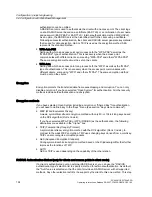
Configuration / project engineering
5.6 Configuration with Web Based Management
SCALANCE W786-xPRO
116
Operating Instructions, Release 08/2007, C79000-G8976-C221-02
Beacons
Beacons are packets that are sent cyclically by an access point to inform clients of its
existence. In the "Beacon Interval" input box, you specify the interval at which the device
sends beacons.
In access point mode only
The "Data Beacon Rate DTIM" parameter (Delivery Traffic Indication Map) specifies how
often the access point sends broadcast and multicast packets over the wireless interface. If
you enter 1 in this box, the access point transmits broadcast and multicast packets directly
after each beacon (recommended setting for normal network environments). The value 5
would mean that the access point collects the broadcast and multicast packets and sends
them after every fifth beacon.
Increasing this value allows a longer sleep mode for the clients but means a greater delay for
broadcast and multicast packets.
Note
The lowest basic rate in the INTERFACE
\
WLAN
\
DATARATES menu is used as the "Beacon
Rate". The higher the data rate of the beacon, the shorter the range of the beacon.
RTS/CTS
RTS/CTS (Request To Send/Clear To Send) is a method for avoiding collisions based on the
exchange of status information before sending the actual data (hidden node problem). To
minimize network load resulting from the additional protocol exchange, this method is used
only when a packet size that you select with the "RTS/CTS Threshold" is exceeded.
Fragmentation
The "Fragmentation Length Threshold" parameter specifies the maximum package size
transferred on the wireless link. Large packets are divided up into small packets prior to
transmission and then reassembled into the original size after they have been received. This
can be beneficial if the transmission quality is poor because larger packets are more difficult
to transmit. However fragmentation into smaller packets means a poorer throughput.
Repetitions
There are two situations in which packets are repeated. The hardware repetition is
performed by the WLAN chip itself when it tries to repeat an unacknowledged packet
immediately. The number of attempted repetitions is specified with the "HW Retry number"
parameter.
If all hardware repetitions were unsuccessful, the packet is withdrawn and all other packets
in the buffer are sent first. Following this, transmission of the packet is attempted again. The
number of such repetitions is specified with the "SW Retry number" parameter.
The software repetition mechanism can be enabled or disabled with "Use SW Retry".
Shortened preamble with 802.11b
The 802.11b standard allows the use of shortened preambles in the wireless transmission of
data packets. This increases the amount of user data.
















































